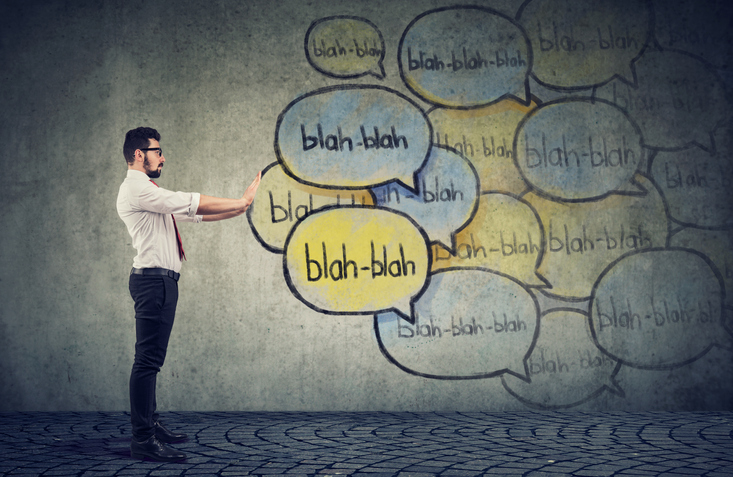Smoother Conversations with ADHD: Tips for managing attention, memory, impulsivity and anxiety while socializing
 Conversations can be tough for folks with ADHD, ASD or LD. It can be difficult to track the conversation flow and stay focused on a subject. You might talk about a topic that seems relevant and related to you but tangential to others. Then, there’s the volume and tone of your voice, reading facial expressions, and difficulty gauging physical proximity. Often times, neurodivergent teens and adults are overly critical of what they are or aren’t doing. You might think you should be worrying about what someone else is thinking about you, rather than being present with what’s going on. Engaging in conversations with ADHD involves coping with multiple ADHD-related challenges while socializing, which isn’t easy for anyone. How can conversations flow easier? Here are tips and tools to help.
Conversations can be tough for folks with ADHD, ASD or LD. It can be difficult to track the conversation flow and stay focused on a subject. You might talk about a topic that seems relevant and related to you but tangential to others. Then, there’s the volume and tone of your voice, reading facial expressions, and difficulty gauging physical proximity. Often times, neurodivergent teens and adults are overly critical of what they are or aren’t doing. You might think you should be worrying about what someone else is thinking about you, rather than being present with what’s going on. Engaging in conversations with ADHD involves coping with multiple ADHD-related challenges while socializing, which isn’t easy for anyone. How can conversations flow easier? Here are tips and tools to help.
Why people with ADHD interrupt conversations more frequently
Interruptions for people with ADHD frequently reflect weaker verbal impulse control, but also issues with working memory and metacognition. You may not remember to wait your turn because you don’t trust yourself to remember what you want to say later–when there’s a pause in the conversation or the other person has finished talking. This reflects a fear of forgetting.  Maybe you are unaware that you are interrupting until someone lets you know. Sometimes people interrupt because they feel a need to prove themselves and establish their expertise. Or, you may really want to engage in this conversation but can’t find a way in, so you interrupt. After all, you’re very excited about this topic and eager to discuss it. At other times, you may be bored and want to change the subject by interrupting. The urge to interrupt is also affected by anxiety. The more anxious you feel in a social situation, the higher likelihood that you will interrupt. Anxiety will exacerbate any nervousness or worries about acceptance, performance and embarrassment. When you are flooded with these intense feelings, you can be naturally more impulsive as a protective measure. In addition, you can be less capable of monitoring your words and actions.
Maybe you are unaware that you are interrupting until someone lets you know. Sometimes people interrupt because they feel a need to prove themselves and establish their expertise. Or, you may really want to engage in this conversation but can’t find a way in, so you interrupt. After all, you’re very excited about this topic and eager to discuss it. At other times, you may be bored and want to change the subject by interrupting. The urge to interrupt is also affected by anxiety. The more anxious you feel in a social situation, the higher likelihood that you will interrupt. Anxiety will exacerbate any nervousness or worries about acceptance, performance and embarrassment. When you are flooded with these intense feelings, you can be naturally more impulsive as a protective measure. In addition, you can be less capable of monitoring your words and actions.
How interrupting impacts connections
Take a moment and reflect on how you feel when someone interrupts you. It seems like they aren’t listening, but rather waiting for their turn to talk. The interrupter is demonstrating that their thoughts are more important than yours. How does that make you feel? Angry, unimportant, dismissed, unseen? Even though interrupting may demonstrate a lack of effective impulse control on your part, other people may not understand this. They may become irritated or impatient, and they probably feel just like you do when you’re interrupted.
Sidetracking conversations with ADHD
 Many people with ADHD go on tangents when they are telling a story or sharing what’s on their mind. This is an understandable part of having many ideas simultaneously. For example, one of my clients recited aloud for me what he was thinking, and it was a nonstop train of observations, interpretations, ideas and curiosity. Do you think your brain does this too? These many ideas lead to sidetracking in conversations. For instance, you may go off track and may not realize that you are too far down a road that goes nowhere until someone tells you. People start looking away or confront you directly, sometimes not so nicely. All too often, neurodivergent kids and adults become defensive. They feel angry and ashamed at the same time. These feelings can make things worse socially and contribute to exclusion or humiliation. Let’s look at some strategies for reducing interruptions.
Many people with ADHD go on tangents when they are telling a story or sharing what’s on their mind. This is an understandable part of having many ideas simultaneously. For example, one of my clients recited aloud for me what he was thinking, and it was a nonstop train of observations, interpretations, ideas and curiosity. Do you think your brain does this too? These many ideas lead to sidetracking in conversations. For instance, you may go off track and may not realize that you are too far down a road that goes nowhere until someone tells you. People start looking away or confront you directly, sometimes not so nicely. All too often, neurodivergent kids and adults become defensive. They feel angry and ashamed at the same time. These feelings can make things worse socially and contribute to exclusion or humiliation. Let’s look at some strategies for reducing interruptions.
5 tips for interrupting less with ADHD
1. Write things down:
Use your phone or a small pad of paper that you keep with you to jot down a few key words that will cue you to recall what it is that you want to say. Whether you are in a meeting or hanging out with friends, let other folks know that you don’t want to interrupt so taking some notes while others are talking helps you remember your thoughts better. This prepares them in case you choose to do this and wards off judgment.
2. Be candid:
If you don’t want to write things down, say, “I have something to share but I don’t want to interrupt you. I’m just afraid that I will forget it.” This warns people of why you are interrupting. You will have to monitor how many times you do this though. Depending on who you’re speaking with, more than a few times in a conversation might be too much. If you do happen to forget something, don’t worry. It will probably come back to you later, and you can text or email them when it does.
3. Watch out for overwhelm:
 Indoor parties, gatherings at a park or beach or eating dinner at a busy restaurant, all of these environments can be extra distracting. It will be harder for you to track what’s being said by whom and staying with the conversation. If you can’t hear or focus on what someone is telling you, ask if you can move somewhere else or step away from the noise for a few moments.
Indoor parties, gatherings at a park or beach or eating dinner at a busy restaurant, all of these environments can be extra distracting. It will be harder for you to track what’s being said by whom and staying with the conversation. If you can’t hear or focus on what someone is telling you, ask if you can move somewhere else or step away from the noise for a few moments.
4. Listen and ask questions:
People like to talk about themselves, and they also like to feel heard. Use reflective listening techniques (“I heard you say X, tell me more about that.”) or (“That sounds interesting. Can you describe/explain it further?”)
5. Use the “WAIT-Now” method:
The “WAIT-Now” method involves periodically asking yourself, “Why am I talking now?” Remember that a pause in a sentence doesn’t mean the person is finished speaking. If you are unsure, wait 10 seconds, and then ask if they’re done before you start speaking.
4 tips for helping conversations flow smoothly with ADHD:
Now that you know how to manage your interruptions, let’s look at some strategies for participating in conversations more effectively with ADHD, ASD or LD:
1. Consider personal space, volume and body language:
Think about the physical proximity of those engaged in the conversation. In the United States, it’s common for people to stand about three feet apart. You also want to consider hand gestures and touching others. Some people are very uncomfortable with being touched casually during an exchange. Initially, keep your hands and body parts to yourself. Later, if you want, you can share that you talk a lot with your hands and ask if a tap on their arm or shoulder would be okay.  Check out the volume and tone of the conversation. How are people speaking? Are you speaking louder or quieter than the people around you? Can you hear yourself? Do you have a buddy who can signal you if you’re too loud or too soft? Observe body language and facial expressions of the folks around you. Interest and engagement look open and calm (relaxed posture, eye contact, leaning forward). Judgment and discomfort look more closed (crossed arms and legs, looking away). What are their faces and bodies showing you about their response to what you are saying?
Check out the volume and tone of the conversation. How are people speaking? Are you speaking louder or quieter than the people around you? Can you hear yourself? Do you have a buddy who can signal you if you’re too loud or too soft? Observe body language and facial expressions of the folks around you. Interest and engagement look open and calm (relaxed posture, eye contact, leaning forward). Judgment and discomfort look more closed (crossed arms and legs, looking away). What are their faces and bodies showing you about their response to what you are saying?
2. Reflect on your behavior in conversations:
Find acceptable alternatives to eye contact if that’s uncomfortable for you. Perhaps engage in an activity during a conversation so people aren’t looking right at you: walking, bicycling, shopping, going to baseball game or visiting a museum. Pause and observe before you enter a room. Get a sense of what’s going on instead of jumping right in by asking “what’s going on?” or interrupting to say something.
3. Make a plan for when you get distracted, space out or start interrupting:
If you lose focus when someone is talking, watch their mouth or hand gestures to follow along. Ask open-ended questions that begin with how and what more than why. How will you get back into the conversation? Could anyone assist you? Likewise, ask a friend or family member to help you with interrupting. Maybe collaborate on a signal that communicates if you’ve wandered too far off topic or have been talking too long.
4. Learn to feel awkward without judgment:
Everybody has insecurities whether they show them or not. You might be uncertain about something, worried about how you compare to others, or worried about how other people perceive you. But it doesn’t mean you should stop making social connections or engaging in conversations. Instead, armed with the tools and strategies described here, you can feel more confident and courageous in meeting new people and making lasting friendships.
Read more blog posts:
- Social Anxiety and ADHD: How to better manage anxiety with supportive planning and preparation
- Tone of Voice Awareness in Neurodiverse Families: How to practice self-regulation in family conflicts
- Taming Emotional Triggers with an ADHD Brain: How to understand big feelings and respond differently
Handouts, Webinars & More in Dr. Saline’s Store:
- Webinar Recording: Navigating College with ADHD: Setting yourself up for success
- Handout: You Can’t Stop Anxiety. You Change Your Relationship with It.
- Handout: Harness GRIT and Get It Done!
Watch on Dr. Saline’s YouTube Channel:
https://youtu.be/LwlMYlV1PX8
